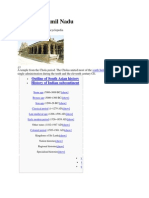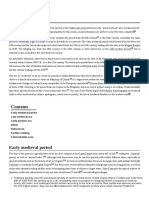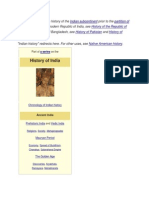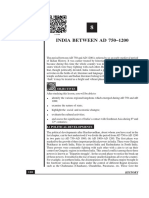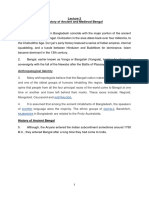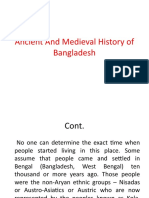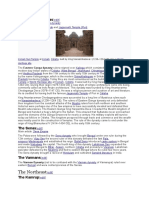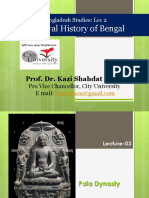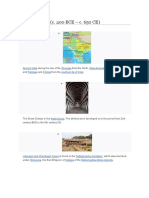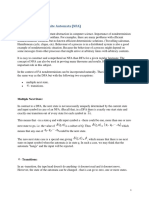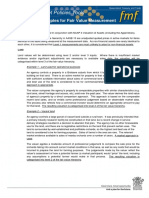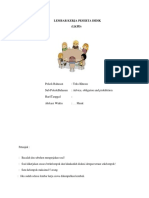Professional Documents
Culture Documents
Early Medieval India History Notes 13
Early Medieval India History Notes 13
Uploaded by
LeeluOriginal Description:
Copyright
Available Formats
Share this document
Did you find this document useful?
Is this content inappropriate?
Report this DocumentCopyright:
Available Formats
Early Medieval India History Notes 13
Early Medieval India History Notes 13
Uploaded by
LeeluCopyright:
Available Formats
Early Medieval India History
Notes
The early medieval period in India is a significant period in terms of development in the fields of
culture, art, language, and religion. The transition between the ancient and medieval periods is
called an early medieval period. With rulers like Prithvi Raj Chauhan, Harshvardhan, Pulakesin
I, and others, this period in history had some of the greatest warriors and rulers.
India from 6th to 14h century spanned from c. 600 to 1200 CE, during which many significant
events took place in northern and southern India during this period. Here, we have shared a
brief overview of the period:
Period Early Medieval Period
Duration 6th to 14th Century
Major Kings Harshavardhana, Prithvi Raj Chauhan, Pulakesin I, Pulakesin II
Major Dynasties Pallava dynasty, Chola dynasty, Chalukya dynasty
Early Medieval Period in India
In early medieval history of India, the northern and southern parts of the country were going
through different phases and unique events. During the early years of medieval India, the
northern parts of the country were under the reign of three major rulers from c. 600 to 750 CE.
Meanwhile, southern India comprised three leading states - the Chalukyas of Badami, the
Pandyas of Madurai, and the Pallavas of Kanchi. Here is some more information about India
from 6th to 14th century -
• The gradual collapse of the Gupta Empire from 480 to 550 CE is considered to be the
beginning of the early medieval period in India.
• During early medieval India, there was no major state in north India and the area was
ruled by multiple smaller dynasties.
• There was no dynasty that ruled over the major parts of the entire country until the Delhi
Sultanate.
Early Medieval India: 750 to 1200 CE
During the early medieval period, from 500 to 750 CE, the main kingdoms were the Pallavas,
the Chalukyas, and the Pandyas. This period witnessed the expansion of the agrarian economy
and saw a decline in trade. Early medieval period in India can be further divided into two
phases, from c. 750 to 1200 CE. Here are the details about these two phases -
From 750 to 1000 CE
During the first phase, north India experienced the reigns of three major emperors, Gurjara
Pratiharas, the Palas, and the Rashtrakutas. Therefore, this age is also known as the age of
three empires. These kingdoms ruled over the major parts of northern and Deccan India. While
the Pratiharas and Gurjaras ruled north India, the Rashtrakutas ruled over the Deccan parts of
India during the early medieval period.
From 1000 to 1200 CE
The second phase of the early medieval period is referred to as the age of conflict in history.
During this period, many rulers had conflicts with each other to expand their empires. The
Rajput dynasties in India were also facing conflicts during this time in the early medieval period
in India.
India From 6th to 14th Century
During the early medieval period in India, several kings ruled over their small empires. The north
Indian state disintegrated into smaller Rajput regions that were controlled by various dynasties
like Chandellas, Paramaras, and Chahamanas. Towards the end of the early medieval period in
India, the states collectively opposed the Turkish attacks led by Mohammad Ghori and Mahmud
Ghazni in 1100 and 1200 CE.
The period from 850 to 1200 CE was mostly under the rule of the Cholas in the South. We have
shared some more information about early medieval India below.
Early Medieval Period: North India
The early medieval period brought an end to one of the biggest empires in Indian history, the
Gupta empire. After the fall of the Gupta kingdom, entire northern India disintegrated into
smaller kingdoms. This major event in history was followed by the establishment of the
Pushyabhutis of Thaneswar in the north.
In the later years of early medieval India, many southern rulers also began trying to conquer the
north. The great King Harshavardhana also ruled the north Indian empire for a brief period
between 606 – c. 647 CE.
Early Medieval India: South India
The history of the early medieval period in South India is both rich and extensive. A number of
great rulers ruled the many states of south India. Here, we have shared some of the most
important rulers in southern India during the early mediaeval period -
• The Pallavas
• The Cholas
• The Chalukyas
• The Eastern and Western Gangas
Major Dynasties of Early Medieval India
Several dynasties were in conflict with each other during the early mediaeval period. This period
of the conflict began after the fall of the Gupta empire in the north. Consequently, the empire of
the north was broken into many smaller kingdoms. Here, we have shared details about the
northern and southern major dynasties of early medieval India.
Major Dynasties in North India
In the early medieval period, North India witnessed a dramatic fall of the Gupta empire, after
which, several regional kingdoms were formed. The major dynasties in North India during this
period were -
• The Makuhari Dynasty was ruled by Hari Varhmana Maukhari in mid 6th century.
• Empire of Harsha - King Harshavardhan had control over entire north India from 601 to
647 CE.
• The Gurjara-Pratihara dynasty, was also the last largest dynasty in north India. This
dynasty ruled a significant portion of northern India from the 6th century to 11th century.
They were called the Imperial Pratiharas.
• In the east, the last major Buddhist rulers of the Pala Empire were administering Bengal
from the 8th to 12th centuries in early medieval India. They also briefly ruled most of
north India during the 9th century.
Major Dynasties in South India
Southern India had some of the richest cultural, social, and architectural developments during
the early medieval period. The major dynasties in South India that contributed to these
developments were -
• Pallava dynasty - From the 3rd to 9th centuries, the Pallavas ruled the entire Telugu
region and parts of Tamil Nadu.
• Chalukya dynasty - Between the 6th to 12th centuries, the Chalukhya dynasty ruled the
western Deccan and some parts of South India.
• Rashtrakuta dynasty- This Kannada dynasty ruled significant parts of the Indian
subcontinent 6th to 10th centuries. The World Heritage site of Ellora was built during the
rule of this dynasty.
• Eastern Chalukyas - This South Indian Kannada-Telugu dynasty ruled from 7th and
12th centuries in the early medieval period in India.
• Chola Empire - This is one of the most powerful South Indian empires, which ruled from
Tamil Nadu. The reach of the Chola empire extended towards many Southeast Asian
territories. The Chola Empire ruled from the 9th to 13th centuries.
• Western Ganga dynasty - This dynasty existed from 350 to 1000 CE and was a
significant dynasty of ancient Karnataka. The famous monolithic Bahubali of
Shravanabelagola was built during the rule of the Western Ganga dynasty.
• Eastern Ganga dynasty - the Eastern Ganga dynasty ruled over the Odisha region
during the early medieval period. The rulers of the dynasty built the famous Jagannath
Temple and Konark Sun Temple.
Characteristics of Early Medieval India
During early medieval India, Sanskrit became the official language in the peninsular area, and
Brahmanism was followed largely. North India disintegrated into much smaller kingdoms during
this period after the fall of the Gupta empire.
• The Chalukyas contributed to some of the most stunning architecture, such as the cave
temples of Ellora and Ajanta.
• All in all, the early medieval period in India was an exciting time with a lot of socio-
political disturbances and developments going on.
You might also like
- History of Tamil NaduDocument29 pagesHistory of Tamil Nadusaravanakavi24No ratings yet
- Anatomically Modern Humans Homo ErectusDocument2 pagesAnatomically Modern Humans Homo ErectusAkash ArvikarNo ratings yet
- BA His Medieval India SocietyDocument113 pagesBA His Medieval India SocietyDNRathNo ratings yet
- Homo Sapiens Homo Erectus:, As Long As 75,000 YearsDocument3 pagesHomo Sapiens Homo Erectus:, As Long As 75,000 Yearssharma.shireesh264808No ratings yet
- Medieval IndiaDocument4 pagesMedieval IndiaVijay kumarNo ratings yet
- As Long As 75,000 Years Ago, or With Earlier Hominids IncludingDocument2 pagesAs Long As 75,000 Years Ago, or With Earlier Hominids IncludingRaju SkNo ratings yet
- Ancient History of Bengal Lec - 02Document5 pagesAncient History of Bengal Lec - 02abdzawad00007No ratings yet
- Homo Sapiens Homo Erectus:, As Long As 75,000Document2 pagesHomo Sapiens Homo Erectus:, As Long As 75,000Gayathri DeviNo ratings yet
- The Indian CivilizationDocument14 pagesThe Indian CivilizationSharmin AkterNo ratings yet
- History of India: Homo Sapiens Homo ErectusDocument2 pagesHistory of India: Homo Sapiens Homo ErectusAndrea GarciaNo ratings yet
- Earliest Human PresenceDocument17 pagesEarliest Human PresenceSharmin AkterNo ratings yet
- Indian SocietyDocument6 pagesIndian Societyavneeshbansal1993No ratings yet
- History of IndiaDocument1 pageHistory of IndiaAppoorv DuaNo ratings yet
- Homo Sapiens Homo ErectusDocument2 pagesHomo Sapiens Homo ErectusStalin JawaharNo ratings yet
- History of IndiaDocument55 pagesHistory of IndiaavtechnoNo ratings yet
- India Between Ad 750-1200Document12 pagesIndia Between Ad 750-1200Vaibhav Kumar Singh kalhans thakur kshatriyasNo ratings yet
- NCH L-6 (Courtesy by Kaisar) - Suraiya IslamDocument4 pagesNCH L-6 (Courtesy by Kaisar) - Suraiya IslamMd. Kaisar SyedNo ratings yet
- Medieval History of India: The PalasDocument2 pagesMedieval History of India: The PalasMithelesh KoulNo ratings yet
- History of IndiaDocument2 pagesHistory of IndiaScribdTranslationsNo ratings yet
- The Ancient BengalDocument13 pagesThe Ancient Bengalfaysal934ahmedNo ratings yet
- History of IndiaDocument38 pagesHistory of IndiakineticgangstaNo ratings yet
- History of India: Homo ErectusDocument3 pagesHistory of India: Homo ErectusHitesh MendirattaNo ratings yet
- Indian HistoryDocument7 pagesIndian HistoryzaheerNo ratings yet
- The Tripatite StruggleDocument2 pagesThe Tripatite StruggleDiv RajNo ratings yet
- Religion in Mughal EmpireDocument25 pagesReligion in Mughal EmpireArthi GaddipatiNo ratings yet
- Maurya Empire Prakrit Pali Sangam Literature Wootz Steel Gupta Empire Hindu Golden Age of India Hinduism Buddhism Mediterranean Greater IndiaDocument1 pageMaurya Empire Prakrit Pali Sangam Literature Wootz Steel Gupta Empire Hindu Golden Age of India Hinduism Buddhism Mediterranean Greater IndiamoneybackNo ratings yet
- The Chola HistoryDocument1 pageThe Chola Historydge4scribNo ratings yet
- History India 13 To 26Document14 pagesHistory India 13 To 26VISHAL GUPTANo ratings yet
- 07 - Chapter 2Document22 pages07 - Chapter 2Azimul Aktar BarbhuiyaNo ratings yet
- North Indian FoodDocument74 pagesNorth Indian Foodlavanya mohanNo ratings yet
- History of IndiaDocument1 pageHistory of Indiavrohit308No ratings yet
- Bba Gagf01Document109 pagesBba Gagf01Vijay KumarNo ratings yet
- Ancient BengalDocument32 pagesAncient Bengalmyself.azeem04No ratings yet
- Classical and Early Medieval Periods of IndiaDocument17 pagesClassical and Early Medieval Periods of IndiaAchuuth KarthickNo ratings yet
- Notes 2Document1 pageNotes 2Anonymous R8k6avDNo ratings yet
- Assignment His103Document7 pagesAssignment His103Georgee78No ratings yet
- Indian CulturDocument1 pageIndian CulturzimfozakNo ratings yet
- Ifp 4Document1 pageIfp 4Sricharan 2107No ratings yet
- Lec 2 - Ancient and Medievel History PDFDocument12 pagesLec 2 - Ancient and Medievel History PDFSabbirNo ratings yet
- Heritage of India: The Gupta EmpireDocument14 pagesHeritage of India: The Gupta EmpireSONI DEEKSHITHANo ratings yet
- Ancient and Medieval History of BangladeshDocument37 pagesAncient and Medieval History of BangladeshMahfuzul saimonNo ratings yet
- Indian HistoryDocument179 pagesIndian Historydevashish12No ratings yet
- Civilization 5Document5 pagesCivilization 5Brinzei LucianNo ratings yet
- Medieval History 01 - Daily Class Notes (Sankalp (UPSC 2024) )Document13 pagesMedieval History 01 - Daily Class Notes (Sankalp (UPSC 2024) )anuraghavsingh01No ratings yet
- Mahajanapadas: Ajanta Caves Aurangabad MaharashtraDocument4 pagesMahajanapadas: Ajanta Caves Aurangabad MaharashtraHarshit ShuklaNo ratings yet
- Indian HistoryDocument27 pagesIndian HistoryRaja Mohan GopalakrishnanNo ratings yet
- IndiaDocument10 pagesIndiaUnnikrishnan RajanNo ratings yet
- Ancient IndiaDocument39 pagesAncient IndiaUnnikrishnan RajanNo ratings yet
- Chapter-I: Tantrā, Etc. Were Significant DevelopmentsDocument47 pagesChapter-I: Tantrā, Etc. Were Significant DevelopmentsManish SainiNo ratings yet
- Lecture-2 - Mediaval Bangla-Revised 8.12.23Document22 pagesLecture-2 - Mediaval Bangla-Revised 8.12.23Mohammad Mahin SarkarNo ratings yet
- Classical Period (C. 200 BCE - C. 650 CE)Document5 pagesClassical Period (C. 200 BCE - C. 650 CE)Rajashekar PrasadNo ratings yet
- DynastyDocument19 pagesDynastymrmahin429No ratings yet
- History of Bangladesh Bangladesh EconomyDocument14 pagesHistory of Bangladesh Bangladesh EconomyAl Faruque0% (1)
- Gupta Empire Upsc Notes 32Document4 pagesGupta Empire Upsc Notes 32William StainsNo ratings yet
- Attachment Medieval Indian History Lyst4337Document110 pagesAttachment Medieval Indian History Lyst4337mr.marwari.sahebNo ratings yet
- Hindu - Buddhist-Muslim Dynasties (Lec 3)Document36 pagesHindu - Buddhist-Muslim Dynasties (Lec 3)arid zeusNo ratings yet
- The Maurya Empire: A Captivating Guide to the Most Expansive Empire in Ancient IndiaFrom EverandThe Maurya Empire: A Captivating Guide to the Most Expansive Empire in Ancient IndiaNo ratings yet
- Nondeterministic Finite Automata (NFA) : Multiple Next StateDocument4 pagesNondeterministic Finite Automata (NFA) : Multiple Next StateSoumodip ChakrabortyNo ratings yet
- Jora Incident Template Guidelines AIR Operations: LimitedDocument43 pagesJora Incident Template Guidelines AIR Operations: LimitedPaolo DidioNo ratings yet
- Sample Treatment PlanDocument3 pagesSample Treatment PlanLiza NaumannNo ratings yet
- SF0R3G42: Low Power Switching and Control ApplicationsDocument7 pagesSF0R3G42: Low Power Switching and Control ApplicationsGoran ChaparNo ratings yet
- FC113X-C Cummins - Leroy GRDocument7 pagesFC113X-C Cummins - Leroy GRIsrael GomezNo ratings yet
- Children Left Behind New Brooms: Economists Expect No More QE For Europe in 2016 Despite Draghi VowDocument26 pagesChildren Left Behind New Brooms: Economists Expect No More QE For Europe in 2016 Despite Draghi VowstefanoNo ratings yet
- Transform Your Business Using Design ThinkingDocument3 pagesTransform Your Business Using Design ThinkingLokesh VaswaniNo ratings yet
- Ncap Tools Illustrative Examples Fair Value MeasurementDocument8 pagesNcap Tools Illustrative Examples Fair Value MeasurementClea Marie MissionNo ratings yet
- General ElectricDocument4 pagesGeneral ElectricCesar AlbertoNo ratings yet
- NeXpose InstallDocument46 pagesNeXpose InstallmadnanfayyazNo ratings yet
- LKPD Rencana Aksi 3Document11 pagesLKPD Rencana Aksi 3Ardi AnsyahNo ratings yet
- Seminar 4 - SolutionsDocument4 pagesSeminar 4 - SolutionsphuongfeoNo ratings yet
- Culture of United States of AmericaDocument108 pagesCulture of United States of Americadarekarsandeep2100% (1)
- Student Industrial Work Experience SchemeDocument29 pagesStudent Industrial Work Experience Schemewinifred ekpoNo ratings yet
- MA311M Assignment 2 - Code Listing: Animesh Renanse - 180108048 September 2020Document4 pagesMA311M Assignment 2 - Code Listing: Animesh Renanse - 180108048 September 2020Animesh SinghNo ratings yet
- National Service - ESL Lesson PlanDocument19 pagesNational Service - ESL Lesson PlanmarcoaulasdeinglesNo ratings yet
- Developing A Test Rig To Measure Hydro-Abrasive Erosion in Pelton TurbineDocument13 pagesDeveloping A Test Rig To Measure Hydro-Abrasive Erosion in Pelton TurbineanantNo ratings yet
- Did Someone Say ParticipateDocument2 pagesDid Someone Say ParticipateAkansha RastogiNo ratings yet
- Question Bank FlyersDocument11 pagesQuestion Bank FlyersCatherine YangNo ratings yet
- 3.1.1.A SequentialLogic - D FlipFlops - JK FlipFlops-1Document6 pages3.1.1.A SequentialLogic - D FlipFlops - JK FlipFlops-1HenryNo ratings yet
- 2022 Pcic 0559Document9 pages2022 Pcic 0559sunilNo ratings yet
- Complexometric Titration of ZincDocument1 pageComplexometric Titration of ZincMireliz Corilloclla100% (1)
- (Huebner International Series On Risk, Insurance and Economic Security) Klugman, S.a.-Bayesian Statistics in Actuarial Science - With Emphasis On Credibility. 15-Kluwer Academic Publishers (1992)Document125 pages(Huebner International Series On Risk, Insurance and Economic Security) Klugman, S.a.-Bayesian Statistics in Actuarial Science - With Emphasis On Credibility. 15-Kluwer Academic Publishers (1992)Abhinav ChatterjeeNo ratings yet
- Type 1 Diabetes DissertationDocument7 pagesType 1 Diabetes DissertationPaperWriterUK100% (1)
- Industry Study PPTGROUP 19 UpdatedDocument13 pagesIndustry Study PPTGROUP 19 UpdatedShivam NaiduNo ratings yet
- Roster DesignDocument2 pagesRoster DesignMinilik Tikur SewNo ratings yet
- Revolutionlessonppt 120515101947 Phpapp02Document30 pagesRevolutionlessonppt 120515101947 Phpapp02Jomar DerayNo ratings yet
- DIDIDocument3 pagesDIDIRamon GarciaNo ratings yet
- Caterpillar 247b2 and 257b2 Multi Terrain Loader Electrical System SchematicDocument1 pageCaterpillar 247b2 and 257b2 Multi Terrain Loader Electrical System Schematicjustin100% (61)
- Reading Anthology PDFDocument17 pagesReading Anthology PDFLoops EspíndolaNo ratings yet
